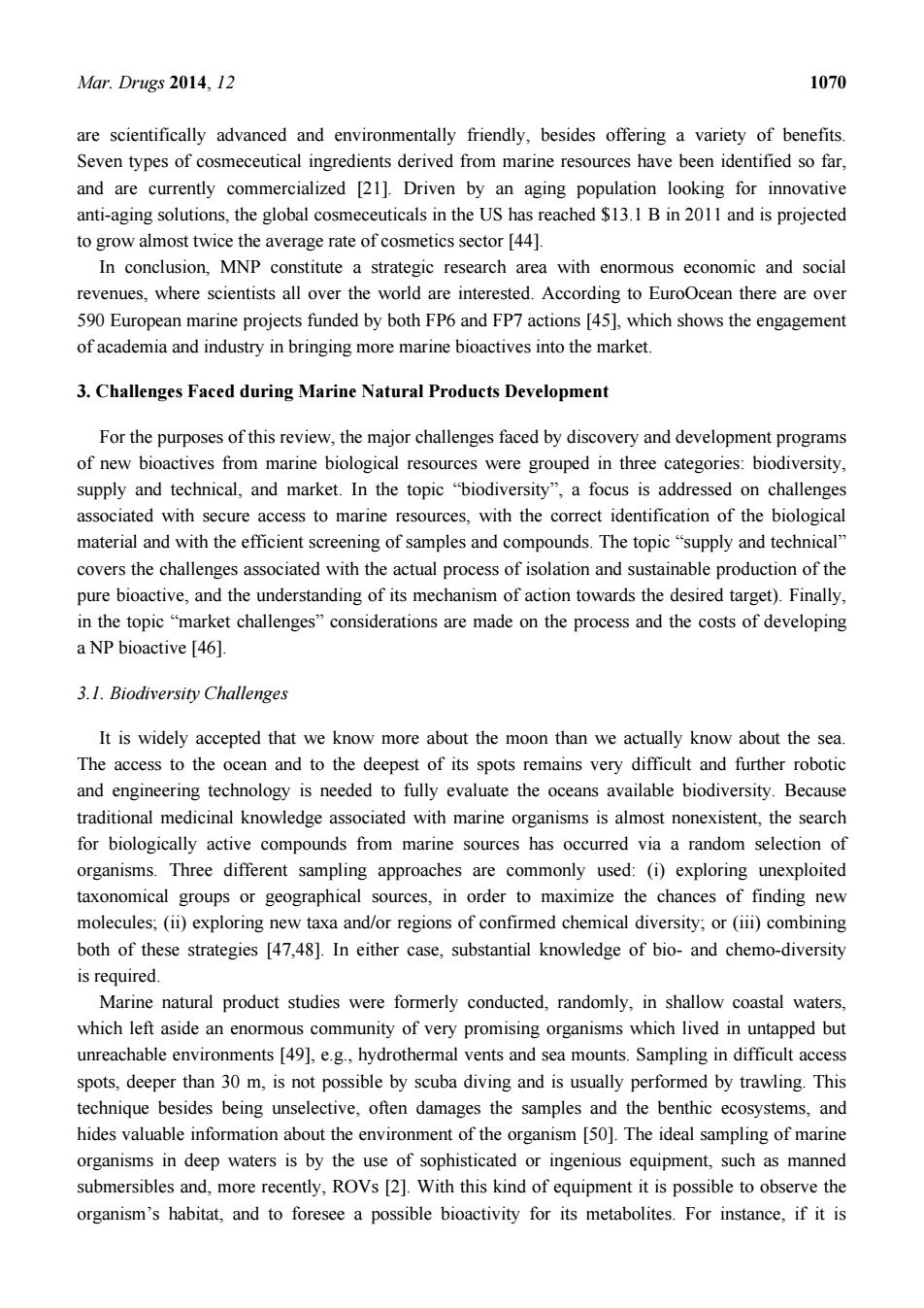正在加载图片...

Mar.Drugs 2014.12 1070 are scientifically advanced and environmentally friendly,besides offering a variety of benefits. Seven types of cosmeceutical ingredients derived from marine resources have been identified so far and are currently commercialized [21].Driven by an aging population looking for innovative anti-aging solutions,the global cosmeceuticals in the US has reached $13.1 B in 2011 and is projected to grow almost twice the average rate of cosmetics sector [44] In conclusion.MNP constitute a strategic research area with enormous economic and social revenues,where scientists all over the world are interested.According to EuroOcean there are over 590 European marine projects funded by both FP6 and FP7 actions [45],which shows the engagement of academia and industry in bringing more marine bioactives into the market 3.Challenges Faced during Marine Natural Products Development For the purposes of this review,the major challenges faced by discovery and development programs of new bioactives from marine biological resources were grouped in three categories:biodiversity. supply and technical,and market.In the topic "biodiversity",a focus is addressed on challenges associated with secure access to marine resources,with the correct identification of the biological material and with the efficient screening of samples and compounds.The topic "supply and technical" covers the challenges associated with the actual process of isolation and sustainable production of the pure bioactive,and the understanding of its mechanism of action towards the desired target).Finally, in the topic "market challenges"considerations are made on the process and the costs of developing a nP bioactive 1461 3.1.Biodiversity Challenges It is widely accepted that we know more about the moon than we actually know about the sea The access to the ocean and to the deepest of its spots remains very difficult and further robotic and engineering technology is needed to fully evaluate the oceans available biodiversity.Because traditional medicinal knowledge associated with marine organisms is almost nonexistent,the search for biologically active compounds from marine sources has occurred via a random selection of organisms.Three different sampling approaches are commonly used:(i)exploring unexploited taxonomical groups or geographical sources,in order to maximize the chances of finding new molecules;(ii)exploring new taxa and/or regions of confirmed chemical diversity;or(iii)combining both of these strategies [47,48].In either case,substantial knowledge of bio-and chemo-diversity is required. Marine natural product studies were formerly conducted,randomly,in shallow coastal waters which left aside an enormous community of very promising organisms which lived in untapped but unreachable environments [49],e.g.,hydrothermal vents and sea mounts.Sampling in difficult access spots,deeper than 30 m,is not possible by scuba diving and is usually performed by trawling.This technique besides being unselective.often damages the samples and the benthic ecosystems,and hides valuable information about the environment of the organism [50].The ideal sampling of marine organisms in deep waters is by the use of sophisticated or ingenious equipment,such as manned submersibles and,more recently,ROVs [2].With this kind of equipment it is possible to observe the organism's habitat,and to foresee a possible bioactivity for its metabolites.For instance,if it is Mar. Drugs 2014, 12 1070 are scientifically advanced and environmentally friendly, besides offering a variety of benefits. Seven types of cosmeceutical ingredients derived from marine resources have been identified so far, and are currently commercialized [21]. Driven by an aging population looking for innovative anti-aging solutions, the global cosmeceuticals in the US has reached $13.1 B in 2011 and is projected to grow almost twice the average rate of cosmetics sector [44]. In conclusion, MNP constitute a strategic research area with enormous economic and social revenues, where scientists all over the world are interested. According to EuroOcean there are over 590 European marine projects funded by both FP6 and FP7 actions [45], which shows the engagement of academia and industry in bringing more marine bioactives into the market. 3. Challenges Faced during Marine Natural Products Development For the purposes of this review, the major challenges faced by discovery and development programs of new bioactives from marine biological resources were grouped in three categories: biodiversity, supply and technical, and market. In the topic ―biodiversity‖, a focus is addressed on challenges associated with secure access to marine resources, with the correct identification of the biological material and with the efficient screening of samples and compounds. The topic ―supply and technical‖ covers the challenges associated with the actual process of isolation and sustainable production of the pure bioactive, and the understanding of its mechanism of action towards the desired target). Finally, in the topic ―market challenges‖ considerations are made on the process and the costs of developing a NP bioactive [46]. 3.1. Biodiversity Challenges It is widely accepted that we know more about the moon than we actually know about the sea. The access to the ocean and to the deepest of its spots remains very difficult and further robotic and engineering technology is needed to fully evaluate the oceans available biodiversity. Because traditional medicinal knowledge associated with marine organisms is almost nonexistent, the search for biologically active compounds from marine sources has occurred via a random selection of organisms. Three different sampling approaches are commonly used: (i) exploring unexploited taxonomical groups or geographical sources, in order to maximize the chances of finding new molecules; (ii) exploring new taxa and/or regions of confirmed chemical diversity; or (iii) combining both of these strategies [47,48]. In either case, substantial knowledge of bio- and chemo-diversity is required. Marine natural product studies were formerly conducted, randomly, in shallow coastal waters, which left aside an enormous community of very promising organisms which lived in untapped but unreachable environments [49], e.g., hydrothermal vents and sea mounts. Sampling in difficult access spots, deeper than 30 m, is not possible by scuba diving and is usually performed by trawling. This technique besides being unselective, often damages the samples and the benthic ecosystems, and hides valuable information about the environment of the organism [50]. The ideal sampling of marine organisms in deep waters is by the use of sophisticated or ingenious equipment, such as manned submersibles and, more recently, ROVs [2]. With this kind of equipment it is possible to observe the organism‘s habitat, and to foresee a possible bioactivity for its metabolites. For instance, if it is